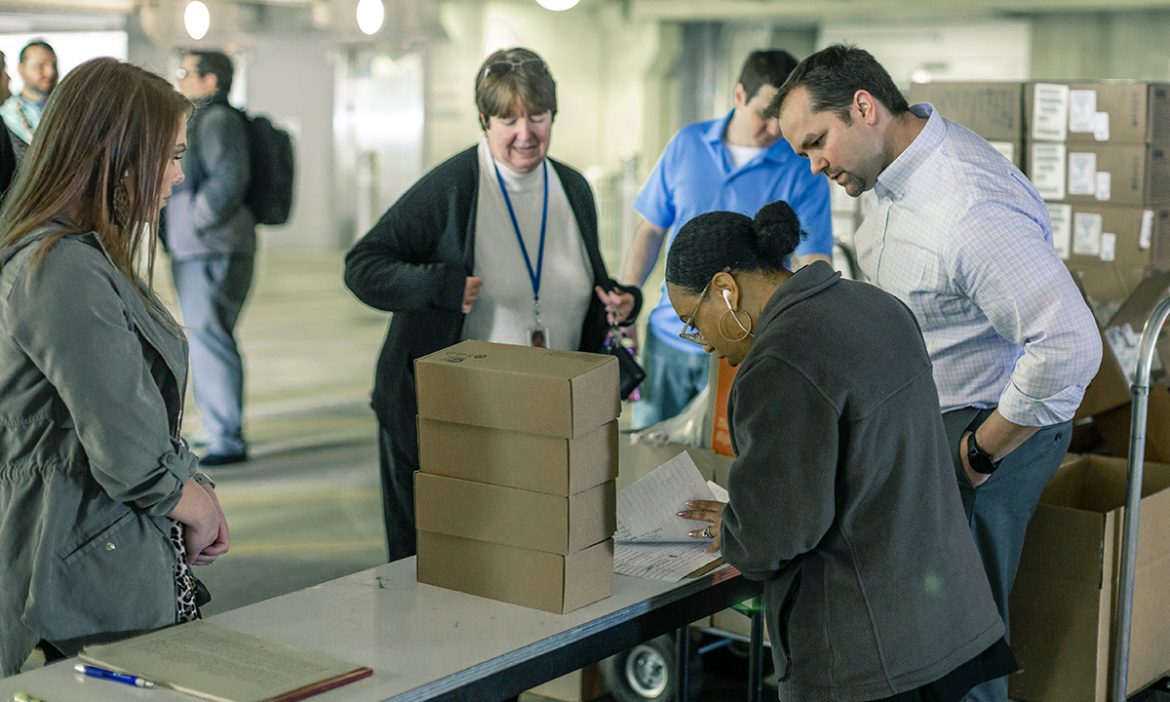To help curb the spread of COVID-19, businesses in Tennessee and around the country have moved employees to working from home. In Chattanooga, BlueCross moved quickly in this transition. Virtually all employees in our six offices throughout the state were moved to teleworking over a period of weeks , and as a result, we have continued to serve our members consistently throughout the pandemic.
We spoke to Aaron Officer, end-user services manager at BlueCross, about the process for transitioning employees and how his team rose to the challenge.
When did you all find out you would start transitioning employees to working from home and how did your team mobilize?
Aaron: Well, the company actually began preparing for a potential move and developing a response plan after the virus first hit in January. Our Information Services teams were ordering equipment to help build inventory even before the move was put into motion.
But regarding the move, I remember exactly where I was when I got that phone call.
We started planning immediately and were actually mobilizing and implementing on Friday, March 6. The majority of the transition was completed by March 16.
How did you all find out which employees would be moving?
Aaron: Each business unit had an individual that served as the area’s leader for the project. That person sent a list to our infrastructure and operations leaders. They determined how many employees would move each day and from which business areas, and they consolidated it down to a single list for the day. From there, we knew who we needed to help and how many employees we’d be moving.
Each employee was provided a kit to help them set up a work station at home. What was in those kits?
Aaron: Each kit contained equipment to provide a virtual private network (VPN) connection to the office, as well as a network cable, a surge protector to make sure everything was plugging into a protected outlet and two monitors.
Did you all face any challenges getting all the equipment you needed?
Aaron: Oh, absolutely. We were working back through our normal supply chain vendors. Because of the coronavirus, it seemed like every company was going through the same process of transitioning workers to home, so equipment and shipping lanes were becoming scarce. Even if we could get our order placed, we couldn’t guarantee it would arrive when we needed it.
So, we ran low on monitors, surge protectors and network cables, just because of the sheer volume. We had to pull equipment from on-site training rooms to ensure we didn’t run out of monitors while we were waiting on orders to arrive.
Each night, we had to figure out how many devices and how many kits we had left to send people home the next day. So, as we were wrapping up a day, we had to determine that number and communicate it to the business areas.
It was a numbers game – and we literally had to source some items from multiple vendors. Typically, we get some of our equipment already configured, but we were having to configure pieces ourselves to keep up with our schedule. With the help of our network operations and engineering teams, we were able to get some additional fiber in our receiving area that really sped up that process for us.
We had to think creatively the whole time – how can we keep this rolling knowing we’re limited on hardware coming in?

Tell us about the process for employees. What happened once they were notified they’d be working from home?
Aaron: Groups of employees were notified through email each day that they’d be working from home. My team and the human resources team walked around to each employee and helped them unlock their equipment. We also gave them a tote bag for the items they’d be taking home, a packet of instructions and a checklist to bring with them to the parking garage at the end of their work day.
After the employees finished work, they came to level six of our parking garage. When they arrived, my team checked their tote bag to ensure they had the right cables and everything they needed. We double checked that their equipment was correct and provided them with the monitor cable they would need, as well as their monitors.
Employees could pull their cars around to reserved parking spots, and we had team members available to load their items into their vehicles for them.
Most employees left between 3 p.m. and 8 p.m. We started with 50 or 60 employees the first day and quickly ramped up to 160 or 170 at a time by day three.
What resources did you provide to help employees set up their equipment once they got home?
Aaron: Normally, when a new hire or current employee is working from home, they go through a telecommuter training class, and part of that class is learning about their equipment, how it works and how to set it up. We had documentation for that, but we took that and expanded it so it provided each employee with the appropriate instructions depending on their device. We also had a checklist with instructions.
But we realized we could do more. We thought, “Hey, let’s do a video.” We worked with the corporate communications team to produce seven videos that walked employees through their devices and equipment and how to set everything up. Each is less than eight minutes long, and they can all be viewed from any device. All employees had to do was visit our landing page and click on their device model to watch.
But you didn’t just help employees in Chattanooga. You helped statewide as well, right?
Aaron: Yes. One of the things we really prided ourselves on was making sure the process was the same for employees regardless of their location. So, we ensured the same documentation and the same tote bag were distributed — no matter where you were, you knew you were following the same process.
I have team members in Nashville and Memphis who were able to help us there. We don’t have team members in Knoxville and Johnson City, so we sent someone to those locations to drop off packets and distribute equipment.
You all had some extra monitors and did a second distribution. Can you tell us about that?
Aaron: Yes. We wanted to accommodate as many users as possible who might need a second screen, so when we realized we had the ability we offered the opportunity for an additional monitor pickup. It worked in a similar way – the employees pulled into the parking garage during designated times. We were stationed there with equipment, so our team members walked up, got their name and employee ID and brought them a monitor and a cable. The employees never had to get out of their cars. We called it the fast food drive-thru.
Do you know how many pieces of equipment you distributed and how many employees you helped move during the transition?
Aaron: So, over 13 business days, we distributed more than 3,700 pieces of equipment.
By the end of the last week, we moved about 1,100 employees who needed additional equipment home.Well, the effort your team put forth was really impressive, and the transition was pretty seamless. Is there anything else you’d like to share about the process?
Aaron: It was a joint effort across multiple teams and divisions – network operations, which I mentioned, but also human resources and client engineering, as well as shared services, facilities and security, who helped us set up our distribution center in the parking garage. And, of course, the employees. They were flexible and accommodating with us, and that made the process a success.


 Amanda joined the BlueCross BlueShield of Tennessee corporate communications team in 2017. Born and raised in Chattanooga, she has a decade of experience in writing for print and the web, as well as digital marketing.
Amanda joined the BlueCross BlueShield of Tennessee corporate communications team in 2017. Born and raised in Chattanooga, she has a decade of experience in writing for print and the web, as well as digital marketing.